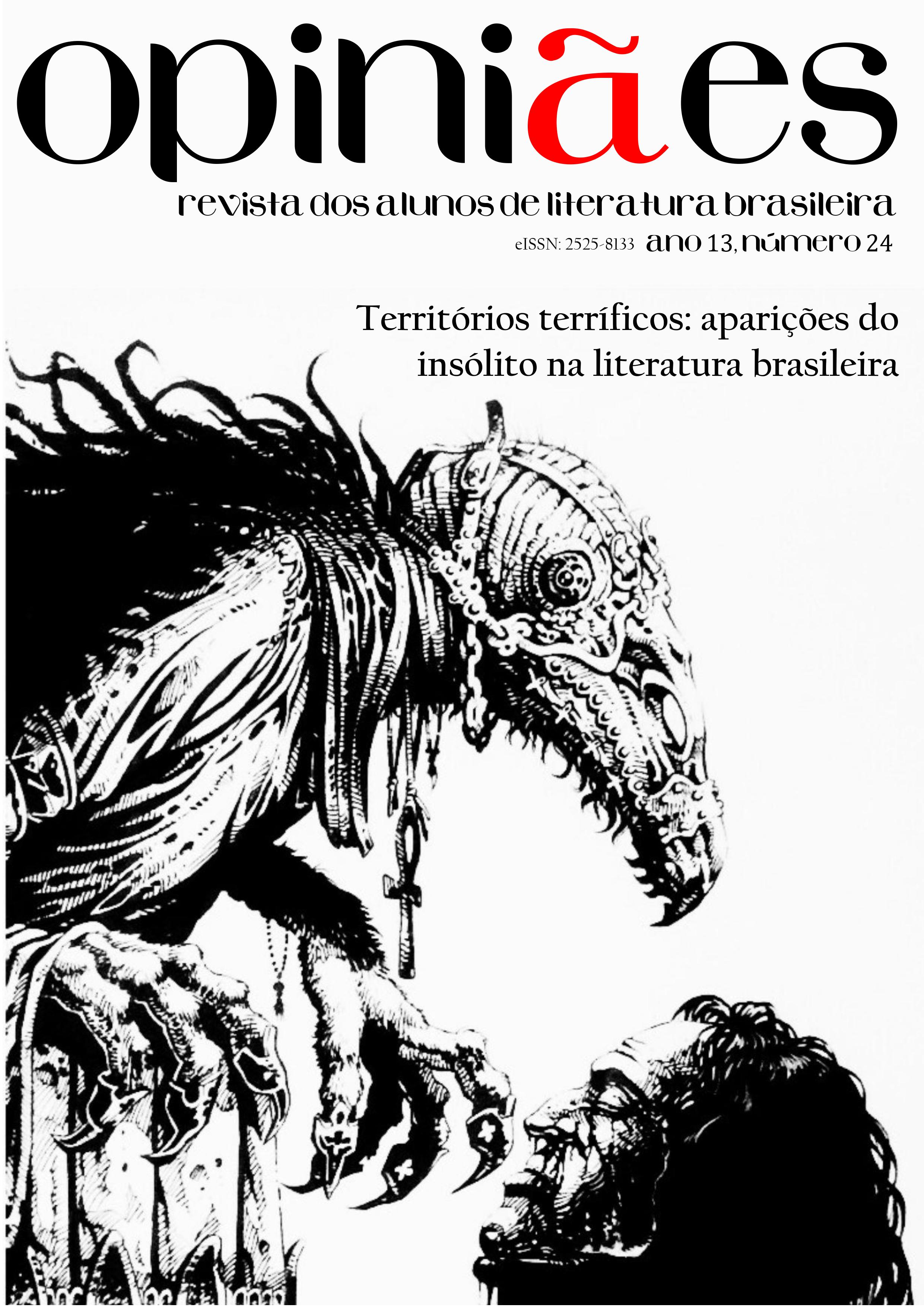The Wandering Jew in Coelho Neto’s Imortalidade (1925)
DOI:
https://doi.org/10.11606/issn.2525-8133.opiniaes.2024.222282Keywords:
Wandering jew, Imortalidade, Coelho NetoAbstract
Despite individual efforts, the figure of the Wandering Jew in Brazilian literature has not been studied enough. The aim of this article is to illustrate how the themes of Faust and the Wandering Jew, which were already mentioned in Matthew Gregory Lewis’s The Monk (2002), are utilized in Coelho Neto’s Imortalidade (1925) in an ingenious combination, which nonetheless contains the fundamental themes of the Wandering Jew narrative: supernatural longevity, wandering and offense against divinity.
Downloads
References
ANDERSON, George Kumler. Popular Survivals of the Wandering Jew in England. The Journal of English and Germanic Philology, v. 46, n. 4, pp. 367-382, 1947.
ANDERSON, George Kumler. The Legend of the Wandering Jew. Providence: Brown University Press, 1965.
ARARIPE JÚNIOR, Tristão de Alencar. Movimento de 1893. O crepúsculo dos povos. Rio de Janeiro: Tipografia da Empresa Democrática Editora, 1896.
BALDICK, Chris. In Frankenstein’s Shadow: Myth, Monstrosity, and Nineteenth-Century Writing. Oxford: Clarendon Press, 1996.
BARING-GOULD, Sabine. Curious Myths of the Middle Ages. Boston: Roberts Brothers, 1867.
COHEN, Richard I. Images et Contexte du Juif Errant Depuis le Mythe Médiéval Jusqu’à la Métaphore Moderne. In: SIGAL-KLAGSBALD, Laurence (ed.). Le Juif Errant: un témoin du temps. Paris: Musée d’art et d’histoire du Judaïsme, 2001. pp. 13-31.
COHEN, Richard I. The ‘‘Wandering Jew’’ from Medieval Legend to Modern Metaphor. In: KARP, Jonathan; KIRSHENBLATT-GIMBLET, Barbara (ed.). The Art of Being Jewish in Modern Times. Filadélfia: University of Pennsylvania Press, 2008. pp. 147-175.
FALCHI, Simonetta. The Wandering Jew and his other self: Faust. In: COCCO, Simona Maria; DELL’UTRI, Massimo; FALCHI, Simonetta (Orgs.). L’altro. I molteplici volti di un’ineludibile presenza. Roma: Aracne editrice, 2012. pp. 47-59.
FELSENSTEIN, Frank. Anti-semitic Stereotypes. A Paradigm of Otherness in English Popular Culture, 1660-1830. Baltimore; Londres: The Johns Hopkins Unversity Press, 1995.
GINWAY, Mary Elizabeth. Introduction. In: COELHO NETO. Esfinge: um romance neogótico do Brasil. Nova York: Modern Language Association of America, 2023. Disponível em: https://www.google.com.br/books/edition/Esfinge/Q4nSEAAAQBAJ?hl=pt-BR&gbpv=0 Acesso em: 6 dez. 2023.
KLIK, Marcin. The Crisis of the Notion of Literary Myth in French Literary Studies. In: LIPSCOMB, Antonella; LOSADA, José Manuel (Org.). Myths in Crisis. The Crisis of Myth. Cambridge: Cambridge Scholars Publishing, 2015. pp. 91-102.
LAMPERT-WEISSIG, Lisa. The Time of the Wandering Jew in the Chronica Majora and the De Brailes Hours. Philological Quarterly 96.2, pp. 171-202, 2017.
LAMPERT-WEISSIG, Lisa. The Transnational Wandering Jew and the Medieval English Nation. Literature Compass, v. 13, n. 12, pp. 771-783, dez. 2016.
LEWIS, Mathew Gregory. The Monk. Nova York: The Modern Library, 2002.
LOPES, Hélio. Ahasvero, tema literário. In: LOPES, Hélio; BOSI, Alfredo (org.). Letras de Minas e outros Ensaios. São Paulo: Editora da Universidade de São Paulo, 1997. pp. 309-314.
COELHO NETO. Imortalidade. Porto: Livraria Chardron, de Lello & Irmão, L.da editores, 1925.
PEREIRA, K. M. de A. O andarilho e o romântico: o mito do Judeu Errante em Castro Alves, Arquivo Maaravi: Revista Digital de Estudos Judaicos da UFMG, v. 8, n. 15, pp. 79-94, 2014. Disponível em: https://periodicos.ufmg.br/index.php/maaravi/article/view/14234. DOI: https://doi.org/10.17851/1982-3053.8.15.79-94. Aecsso em: 01 jul. 2024.
RAILO, Eino. The Haunted Castle: A Study of the Elements of English Romanticism. Nova York: Taylor and Francis, 2019. Disponível em: https://www.perlego.com/book/1503605/the-haunted-castle-a-study-of-the-elements-of-english-romanticism-pdf. Acesso em: 6 dez. 2023.
ROSENBERG, Edgar. From Shylock to Svengali. Jewish Stereotypes in English Fiction. Stanford: Stanford University Press, 1960.
ROUART, Marie-France. The Myth of the Wandering Jew. In: BRUNEL, Pierre (Org.). Companion to Literary Myths, Heroes and Archetypes. Nova York: Routledge, 1996. pp. 826-834.
SCARBOROUGH, Dorothy. The Supernatural in Modern English Fiction. Nova York: The Knickerbocker Press, 1917.
VASCONCELOS, Carolina Michaelis de. O Judeu Errante em Portugal. Revista Lusitana, pp. 34-45, 1887/1889.
VASCONCELOS, Carolina Michaelis de. O Judeu Errante em Portugal. Revista Lusitana, n. 2, pp. 74-76, 1893/1895.
Downloads
Published
Issue
Section
License
Copyright (c) 2024 Ana Resende

This work is licensed under a Creative Commons Attribution 4.0 International License.
A revista Opiniães não exerce cobrança pelas contribuições recebidas, garantindo o compartilhamento universal de suas publicações. Os autores mantêm os direitos autorais sobre os textos originais e inéditos que disponibilizarem e concedem à revista o direito de primeira publicação, com o trabalho simultaneamente licenciado sob a Licença Creative Commons Attribution que permite o compartilhamento do trabalho com reconhecimento da autoria e publicação inicial nesta revista.
Funding data
-
Coordenação de Aperfeiçoamento de Pessoal de Nível Superior
Grant numbers 001



